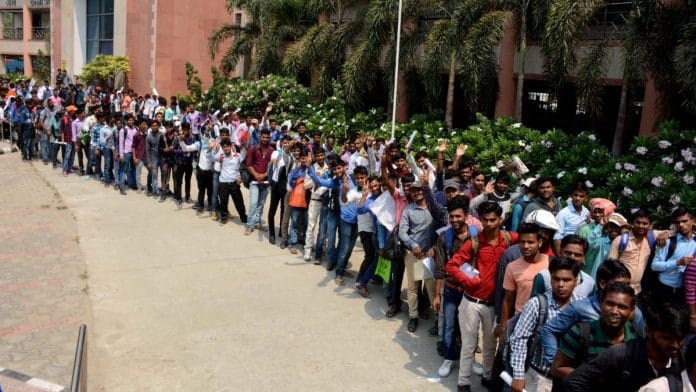Thank you dear subscribers, we are overwhelmed with your response.
Your Turn is a unique section from ThePrint featuring points of view from its subscribers. If you are a subscriber, have a point of view, please send it to us. If not, do subscribe here: https://theprint.in/
I am not sure whether the problem in India is unemployment or unemployability. Probably it is both but more of unemployability.
The present education system in India is largely a legacy of the British Raj, (should have no qualms in admitting it) though it has evolved significantly since independence. The system had its advantage in that it produced a miniscule percentage of the population well versed in the English language, who went out to embrace the world and helped the Indian economy grow. It also left a very large percentage of the local population disadvantaged. The British did the right thing for them, then. They needed a class of educated Indians to help administer the empire. Schools and colleges were designed to produce clerks, administrators, and intermediaries—not innovators or entrepreneurs. Since independence, India has expanded access to education and introduced reforms, but key features—rote learning, rigid curricula, high-stakes exams, and English-language dominance—remain.
Let me explain with two personal experiences in the first decade of this century. I left the Army early and became an entrepreneur at 50, in 2003, and started a MSME whose technology pursuit also included elimination of static electricity in certain industrial processes. We called in electrical engineers for an interview. Seventy percent engineers, fresh out of college, of those we interviewed could not explain static electricity. So much for the engineers India “churned out” of many engineering colleges. We tried recruiting diploma holders from ITI. Lo and behold, we found that such diplomas could be “bought” even without attending an ITI, most of which, in any case, were nonfunctional on ground.
My elder daughter studied architecture in a prestigious university in Baroda from 2005 to 2010. She had to take extra lessons in the use of CAD privately. That cost extra money and took away a lot of time. My younger daughter graduated as an IT engineer from a top college in Bangalore in 2011. During the final two years she attended additional classes in private institutions to learn the latest tools in software development. She was “campus recruited” by Infosys at the end of her course. Oh! no! Even the extra learning my daughter underwent at considerable costs out of college time, was not enough to work at Infosys. So, Infosys sent her, along with all new intake, away to their special institute in Mysore for another six months of education. That was the state of fresh IT engineers in India.
Unemployability refers to a situation where individuals are not equipped with the skills, knowledge, or attitudes required to be employable in the modern job market—even if jobs exist. The root causes in India are outdated curricula in schools and colleges; lack of practical, technical, and soft skills; Inadequate vocational and skill-based training; English language and digital literacy gaps; poor communication and problem-solving abilities. Significant skill gaps exist, especially in engineering, management, and IT sectors A report by India Skills Report, NASSCOM, on India skills report shows that only ~45–50% of Indian graduates are deemed employable by industries. In any case this is an open secret which besides India the whole world is aware of. India’s employment challenge is not just about the quantity of jobs, but also the quality of its workforce. Reducing unemployment requires economic growth and investment in job creation. India has to bring in reforms like in labor, land, farm, judiciary (dispute settlement) and police to invite investments. Most of these subjects being in the concurrent list the states have to come up and help the center in improving the ease of doing business in India. Are the states and politics of elections up to taking up this challenge? Else India will forevr remain a laggard democracy of only elections.
Combating unemployability requires deep reforms in education and a focus on skill development involving creating new universities and colleges with revised curricula. Recent initiatives like the National Education Policy (NEP) 2020 aim to move away from this colonial legacy by emphasizing flexibility, multilingualism, critical thinking, and holistic development.
Higher Education Reforms (Those interested may read the policy on the net for more details) include holistic multidisciplinary education, multi entry and exit options – 1 year: certificate, 2 years: diploma, 3-4 years: degree); academic bank of credits (ABC) which can be accumulated; a single umbrella body to regulate all higher education; Increased Gross Enrollment Ratio (GER); phasing Out of affiliated colleges system:
Indian democracy and governance at both the center and in the states have to move beyond just elections. Democracy is not only the government of the people, by the people and for the people. It also includes efficient governance – probably the centerpiece of democracy, neglected both by governments and the people.
The author is an Indian Army veteran and a contemporary affairs commentator. The views are personal. He can be reached at kl.viswanathan@gmail.com
These pieces are being published as they have been received – they have not been edited/fact-checked by ThePrint.


